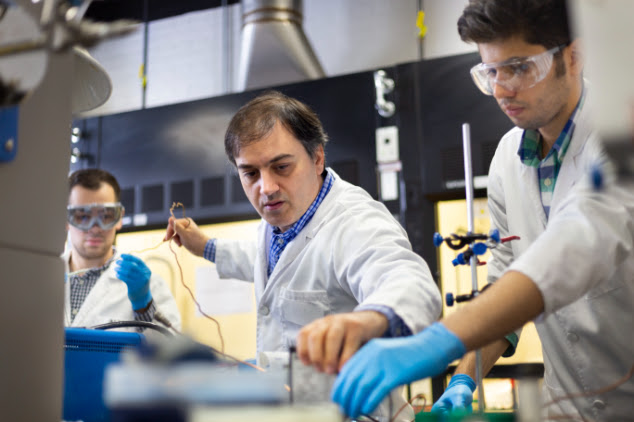Breakthrough in lithium-air batteries could help put more electric vehicles on the road
Illinois Tech Assistant Professor Mohammad Asadi leads development of revolutionary technology that could make lithium-air batteries commercially viable for widespread use in electric vehicles and reduce carbon emissions.
CHICAGO—Illinois Institute of Technology Assistant Professor of Chemical Engineering Mohammad Asadi has developed solutions to two major problems facing lithium-air batteries. Lithium-air batteries hold more energy in a smaller battery size than their more common counterpart, the lithium-ion battery, but until now, lithium-air batteries have been overlooked in commercial applications because lithium-air batteries tended to die after fewer recharges and require a lot more energy to charge than can be generated by the battery later.
After almost a decade working in the oil and gas industry, Asadi turned his focus to carbon dioxide in the atmosphere, particularly caused by the transportation industry, which consumes around 38 to 40 percent of the world’s energy. “With more widespread use of electric vehicles, you can drastically reduce transportation-based carbon emissions,” says Asadi. “But to put more electric vehicles on the road, we’ll need batteries—lots of them.”
Currently, lithium-air batteries are seen as less commercially viable than their counterpart, the lithium-ion battery. However, using lithium-air batteries in electric vehicles has some huge advantages.
“Imagine you have an electrical vehicle today that can run just 300 miles on a single charge,” says Asadi. “If you replace that battery with our technology, the lithium-air battery technology, you can drive up to 1,500 to 2,000 miles–increasing your driving range five to six times with the same weight and the same volume.”
With current lithium-air technology, batteries tend to die after just a few recharges. The number of times a battery can recharge is called its cycle life, and it’s the involvement of air in the lithium-air battery that makes it difficult to get a long cycle life. As it charges, a battery undergoes a chemical reaction between oxygen and lithium at the negatively charged component inside the battery, the cathode. Other elements in the air we breathe, carbon monoxide, nitrogen, and water can react with lithium inside the battery gumming the system, preventing oxygen from reaching the cathode, impeding the chemical reaction and using up the lithium in the battery that makes the battery run.
However, Mohammad Asadi and his team at Illinois Tech have contributed to the development of a unique combination of internal battery components that allow lithium and oxygen to react with minimal interference, as reported in Nature in 2018 and Advanced Materials in 2020.
“With our technology, we can make the chemistry of the cathode favorable only for oxygen reduction and degeneration reactions, avoiding the formation of byproducts that decrease the efficiency of the battery,” says Asadi. “We have also developed a very particular, very novel, hybrid electrolyte that can work together to absorb those impurities.”
This specific mixture for the electrolyte, the liquid that carries the lithium ions between the anode and cathode, also reduces the likelihood that the lithium will react with anything while it travels. Designing this efficient pathway has allowed Asadi to develop a lithium-air battery with a long cycle life, achieving 1,200 charges and discharges in his most recent design.
To handle the efficiency issue, Asadi has been exploring new cathode materials. In a battery, two reactions have to happen at the cathode: formation of lithium peroxide when the battery is being used and the reverse, breaking down that lithium peroxide when the battery is being charged.
While many materials can be used as a catalyst to speed up one of these reactions, it has been a challenge to find a material that can speed up both, an essential component of a high-efficiency battery. In his most recent design, Asadi tested an inexpensive material called trimolybdenum phosphide nanocatalysts, which turned out to be able to efficiently drive both reactions.
“Using our technology, we reach the lowest reported excess energy for this reaction, which also gives us negligible energy loss over the cycling,” says Asadi. “It’s the best lithium-air battery out there.”
While these advances represent a huge step forward for lithium-air batteries, Asadi says there simply isn’t enough lithium on earth to create the number of batteries we need for a fully electrified future. Lithium-air has the advantage of making better use of our limited supply of lithium, but that won’t be enough for a lower carbon future with more electric vehicles in use. Asadi is working on that problem too.
Fortunately, the basic battery design principles are translatable. Asadi thinks other more abundant metals can be developed to create batteries with energy storage comparable to current lithium batteries.
Producing more commercially viable, efficient lithium-air batteries can revolutionize not only the electric vehicle industry, but lithium-air batteries could be used in a wide range of applications including in medical equipment, mobile devices, and even emergency energy storage for electrical grids.











